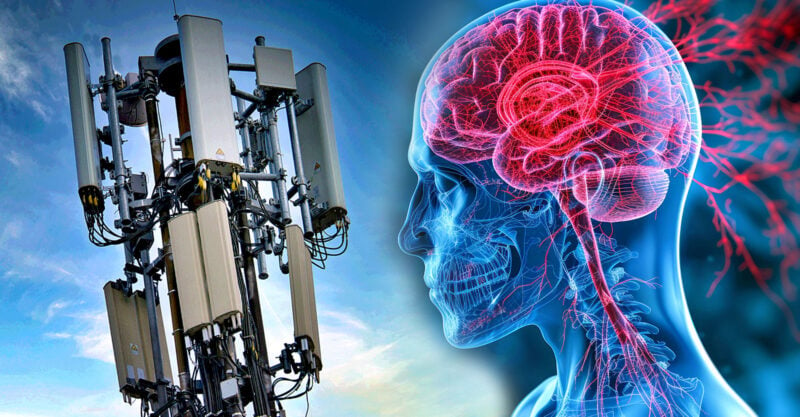Miss a day, miss a lot. Subscribe to The Defender's Top News of the Day. It's free.
A Minnesota woman alleging the radiofrequency radiation emitted by a cell tower near her home triggered 51 strokes on Monday sued AT&T and other companies involved in the operation of the tower.
Children’s Health Defense (CHD), which is funding the lawsuit, filed the complaint on behalf of Marcia Haller, who previously told The Defender she became disabled shortly after the cell tower was “upgraded” in 2019.
In addition to suffering dozens of strokes since then, she’s suffered vision and hearing loss, headaches, sleep disruption, chronic fatigue and cognitive impairment. She also experiences ongoing issues with balance, orientation and mobility.
The lawsuit, filed in the U.S. District Court for the District of Minnesota (Duluth), alleges the companies operating the tower must provide Haller with a “reasonable accommodation” and/or modify their “policies, practices or procedures” to comply with federal disability law.
In addition to AT&T, defendants in the suit include T-Mobile and American Tower.
This is CHD’s second lawsuit leveraging the Americans with Disabilities Act (ADA) on behalf of individuals suffering from radiofrequency (RF) radiation exposure.
“CHD is excited to file the second complaint in this strategic line of cases,” Miriam Eckenfels-Garcia, director of CHD’s Electromagnetic Radiation (EMR) & Wireless program, said.
“We hope we will be able to help Marcia get relief, while at the same time, drive the conversation around electromagnetic sensitivity, RF radiation, and the lack of recourse for those harmed by cell towers forward,” Eckenfels-Garcia said.
The case draws attention to the need for better federal regulation of RF radiation and outlines the scientific evidence that debunks the “RF radiation is safe” narrative, according to Eckenfels-Garcia.
According to the lawsuit, Haller’s physician said that Haller’s symptoms — including “life-threatening embolic strokes” — occur when she is exposed to high levels of RF radiation or pulsated RF radiation, such as 5G.
“Her physical impairments already substantially limit major life activities … and RF exposure triggers and/or exacerbates her symptoms and condition,” the complaint said.
The companies could “easily and with minimal cost” take action to end Haller’s symptoms, “but they have refused to do so” — despite receiving a letter about her symptoms.
The suit asks the court to declare that the ADA applies to Haller’s situation. This would mean that the companies would be liable for discriminating against Haller because they failed to accommodate her disability.
It also seeks injunctive relief, meaning that it wants the court to order the companies to “end the discrimination” by either relocating their tower or reducing the amount of RF radiation it emits.
Haller is requesting a jury trial and compensation for attorney fees and costs.
Cell tower was likely ‘upgraded’ for 5G
Marcia and her husband, Jay, believe the cell tower was upgraded in 2019 for deploying 5G. “They [the companies] won’t admit to what they did,” Marcia told The Defender. “They say they don’t have to tell us.”
Marcia at the time was in her third semester of nursing school and worked as a certified nursing assistant at a hospital.
On the weekend after the upgrade, Marcia was at home and began feeling dizzy and as if something “just didn’t feel right.”
She called Jay, who runs a trucking business, telling him, “Something’s wrong in my head … I don’t know how to explain it. I just feel like crap.” But she told Jay she didn’t need him to come home. “I’ll be fine,” she said.
The physical sensation was “awful,” Marcia said. In addition to dizziness, she had headaches and nausea. “I couldn’t pick my head up off the pillow without the room spinning and feeling very sick.”
‘We think you’re having a stroke’
The symptoms continued. On Monday, she went to urgent care and was diagnosed with vertigo.
She returned home. A few days later, she had blind spots in her vision and tingling in her arm with “almost a numb feeling.”
Marcia called the on-call nurse center. They told her, “You need to come down to the emergency room. We think you’re having a stroke.”
An MRI of Marcia’s brain showed numerous damaged areas called lesions. She was admitted to the hospital on Oct. 10, 2019, and diagnosed with strokes, vision loss and balance difficulties.
After three days in the hospital, the strokes stopped happening — meaning MRIs of her brain showed no new lesions — and Marcia returned home.
But before the end of the month, Marcia “started feeling the same thing again” and went back to the emergency room.
Jay recalled, “We were home — the kid [Marcia and Jay’s son] and I — and she was cooking dinner … She turned around and her face had actually drooped on this one. It was like ‘uh-oh.’”
Marcia went back to the hospital, where she was diagnosed with more brain lesions. A neurologist told Marcia the MRI scan of her brain looked like a “starry night” because of how many white spots, or lesions, appeared.
The doctors still did not know what was causing them, she said.
Multiple trips to the hospital
Over the following weeks, Marcia went “back and forth a few times” between her home and her local hospital.
After a night or two at the hospital, she would begin feeling better. But after returning home, her symptoms reemerged and she’d have to return to the hospital. “Each time, more strokes,” she said.
According to Jay, “A week or 10 days later, there’d be seven or 10 new ones [lesions appearing in the MRI scans]. This was going on for about a month. I think we rounded up to about 51 complete strokes.”
Still, her local hospital doctors couldn’t explain why this was happening.
In November 2019, Marcia saw doctors at the Mayo Clinic who began treating her symptoms with plasmapheresis to put new plasma in her blood, steroids and a medication called CellCept.
But after a second round of treatment, Marcia had more strokes — including one that temporarily impaired her hearing — and she continued to experience extreme fatigue.
‘That’s when we started piecing things together’
During one of Marcia’s stays at the Mayo Clinic, Jay “just woke up” with a strong sense that the cell tower radiation was causing Marcia’s symptoms. “Then he started doing research and that’s when we started piecing things together,” Marcia explained.
Based on what Jay was discovering, he and Marcia decided to try living elsewhere.
On March 3, 2020, they and their son moved into Marcia’s parents’ house a mile further away from the tower. Marcia “got a lot better,” she said. The strokes stopped.
By June, she was talking about returning to school, Jay said. “We’d go fishing every night and she just had a lot more energy.”
Around the same time, Marcia’s doctors at the Mayo Clinic had Marcia taking pill chemotherapy. “So they’re patting themselves on the back for the chemo,” Jay said, “I think it was moving that made it stop.”
But in October 2020, Marcia’s parents returned so Jay, Marcia and their son moved back to their house close to the tower.
In just a week, Marcia started experiencing the same symptoms again.
‘Living through this has stolen a piece of us we will never get back’
Jay and Marcia became more convinced that the RF radiation from the tower was making Marcia sick.
They think living so close to the tower may have been a factor in Jay’s development of rheumatoid arthritis. Their son, too, has had negative health episodes — including a major blood clot in his left arm — that Marcia and Jay suspect may have been linked to the radiation.
Jay said he wouldn’t call it a coincidence that “all members of our household have been struck with rare illnesses and permanent health problems that will impair us for the rest of our lives.”
“Living through this has stolen a piece of us we will never get back,” he added.
Oct. 16, 2020, they hired Frank DiCristina — a certified building biologist and certified EMR specialist — to measure the wireless radiation levels throughout their home.
DiCristina’s report showed peaks of up to 18 milliwatts per squared meter (mW/m2) — which is 18 times higher than what the Standard of Building Biology considers the “extreme limit,” noted DiCristina in the report.
In late October 2020, Jay constructed a Faraday cage — an enclosure with metal lining that blocks out all RF radiation — to give Marcia a place of relief from the radiation.
Having a space free of RF radiation has made a big difference in Marcia’s well-being, but she said it’s not fun having to go into a small enclosed space to feel OK.
She and Jay call the Faraday cage “the penalty box.” It’s a tiny room with no power and no windows — just a “complete black box with two beds,” Marcia said.
She and Jay sleep there, with their 18-year-old son spending the night away from home as often as possible. “I would be nervous to sleep in my house because I don’t want to get sick again,” Marcia said.
Marcia also now wears a silver-lined baseball cap designed to block RF radiation when in her home. With these measures, she slowly was able to complete her nursing program and return to work.
However, she still experiences symptoms on her property when outside the Faraday cage. “Simple things like enjoying the fire pit, gardening and just relaxing on the deck are now basically a memory,” Marcia said.










